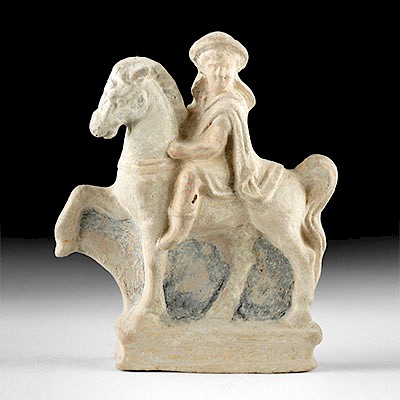Rare Nabataean Glazed Redware Cup w/ Footed Base
Lot 78a
About Seller
Artemis Gallery
686 S Taylor Ave, Ste 106
Louisville, CO 80027
United States
Selling antiquities, ancient and ethnographic art online since 1993, Artemis Gallery specializes in Classical Antiquities (Egyptian, Greek, Roman, Near Eastern), Asian, Pre-Columbian, African / Tribal / Oceanographic art. Our extensive inventory includes pottery, stone, metal, wood, glass and textil...Read more
Estimate:
$2,200 - $3,300
Absentee vs Live bid
Two ways to bid:
- Leave a max absentee bid and the platform will bid on your behalf up to your maximum bid during the live auction.
- Bid live during the auction and your bids will be submitted real-time to the auctioneer.
Bid Increments
| Price | Bid Increment |
|---|---|
| $0 | $25 |
| $300 | $50 |
| $1,000 | $100 |
| $2,000 | $250 |
| $5,000 | $500 |
| $10,000 | $1,000 |
| $20,000 | $2,500 |
| $50,000 | $5,000 |
| $100,000 | $10,000 |
| $200,000 | $20,000 |
About Auction
By Artemis Gallery
May 9, 2019
Set Reminder
2019-05-09 10:00:00
2019-05-09 10:00:00
America/New_York
Bidsquare
Bidsquare : Ancient | Asian | Ethnographic
https://www.bidsquare.com/auctions/artemis-gallery/ancient-asian-ethnographic-4110
Featuring classical antiquities, ancient and ethnographic art from cultures encompassing the globe. All legally acquired, legal to sell. Satisfaction guaranteed. Convenient in-house shipping. Artemis Gallery info@artemisgallery.com
Featuring classical antiquities, ancient and ethnographic art from cultures encompassing the globe. All legally acquired, legal to sell. Satisfaction guaranteed. Convenient in-house shipping. Artemis Gallery info@artemisgallery.com
- Lot Description
Ancient Near East, northern Jordan, Umm el-Jimal, Nabataean peoples, ca. second half of the 1st century CE. A wheel-thrown pottery cup from Umm el-Jimal, one of the oldest and most well-preserved cities of ancient Jordan. The vessel has a concave, tiered foot, an inverted bell-shaped body, a petite flared rim, and a pair of applied handles that twist between the terminals. The exterior of the body boasts an orange-red slip coloration and is covered in a thin layer of lustrous glaze. A register of densely-congregated hash marks courses across the body roughly nine times and terminates just below the handles' lower terminals. A repeating motif of dark circles are enclosed with matching ladder-form borders both above and below, imbuing the cup with a personalized presentation. A beautiful and exceedingly rare example of fine utilitarian ceramics from the ancient Near East! Size: 4.875" W x 4.5" H (12.4 cm x 11.4 cm).
The Nabataean kingdom controlled a string of oases that linked trade between southern Arabia (where many forms of incense required for religious worship were created) and the Greco-Roman world, and flourished throughout most of the 1st century CE. The Nabataean sphere of influence extended far into the Arabian Peninsula towards Yemen along the Red Sea. Its capital of Ragmu (present-day Petra) was one of the largest and most highly-frequented cosmopolitan marketplaces in the Near East, though it was only one in a string of Nabataean settlements strung out in an area with very limited resources.
Provenance: private East Coast, USA collection
All items legal to buy/sell under U.S. Statute covering cultural patrimony Code 2600, CHAPTER 14, and are guaranteed to be as described or your money back.
A Certificate of Authenticity will accompany all winning bids.
We ship worldwide and handle all shipping in-house for your convenience.
#135527Vessel repaired from multiple large pieces with resurfacing, overpainting, and light adhesive residue along break lines. Some areas of restoration and overpainting on the body. Surface wear and abrasions commensurate with age, small nicks to handles, rim, body, and foot, with fading to pigmentation and glaze, and light encrustations within interior. Nice earthen deposits and traces of pigmentation throughout. Old inventory label beneath foot.Condition
- Shipping Info
-
All shipping is handled in-house for your convenience. Your invoice from Artemis Gallery will include shipping calculation instructions. If in doubt, please inquire BEFORE bidding for estimated shipping costs for individual items.
-
- Buyer's Premium



 EUR
EUR CAD
CAD AUD
AUD GBP
GBP MXN
MXN HKD
HKD CNY
CNY MYR
MYR SEK
SEK SGD
SGD CHF
CHF THB
THB
















